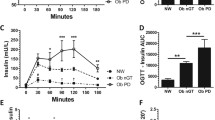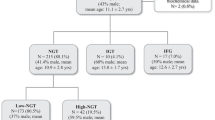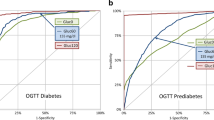Abstract
Detection of Insulin resistance (IR) in normoglycemic young subjects before the onset of Impaired Glucose Tolerance (IGT) is of importance as it affords implementation of preventive measures in such high risk subject. Very few studies have specifically evaluated for the presence of IR in younger age group with normal glucose tolerance. The gold standard for investigating and quantifying insulin resistance is the “hyperinsulinemic euglycemic clamp,” the complicated nature of the “clamp” technique, alternatives have been sought to simplify the measurement of insulin resistance. The oral glucose tolerance test (OGTT) is one of the most commonly used methods to evaluate whole body glucose tolerance in vivo. IR and IS values of HOMA-IR, ISI0–120, QUICKIE mathematical models derived from OGTT have been shown to produce equivalent results as in Euglycemic clamp technique we hypothesized that normoglycemic young adult who are siblings of type II diabetics (SD) probably have higher IR values than the siblings of non diabetics as they are genetically predisposed.
In this study 79 normal young adult volunteers, 40 subjects with family history of diabetes (SD) and 39 subjects without family history of diabetes (SND), in the age range of 18 to 25 years were evaluated for Insulin resistance. Standard (75 g) OGTT was performed on all the study subjects after an overnight fast. Fasting (basal), 30, 120 min venous plasma glucose and Corresponding specific insulin concentration was determined by radioimmuno assay (RIA) using a human specific antibody RIA kit. In each subject, the degree of insulin resistance was estimated by various parameters of Insulin resistance and sensitivity that were calculated using physiological mathematical models like HOMA-IR, ISI0–120, IGI, QUICKIE and their formulas derived from OGTT.
The mean age of the study population was 19.01 (18 to 25 years), Male: 33 (41.3%) and Female: 47 (58.8%). The normoglycemic subjects were categorized as Siblings of Diabetics (SD n = 40) and siblings of non-diabetics (SND n = 39). Both the groups were matched by physical, clinical and routine laboratory parameters and were not statistically significant different. Siblings of diabetics had a statistically significant higher values of insulin at baseline, 30 min and 120 minutes and glucose at 30 minutes. Siblings of diabetics had a significantly higher insulin resistance and lower insulin sensitivity indices as in HOMA-IR (2.01527, p < 0.017), ISI02–120 (56.27, p < 0.002) and I0/G0 ratio (0.122381, p < 0.012) and a trend towards significance for QUICKIE (0.29578, p < 0.056).
Detection of insulin resistance in normoglycemic young adult subjects in pre-disease state is feasible using mathematical models like HOMA IR, ISI0–120 from OGTT. OGTT is simple and a generally acceptable test. Siblings of diabetics had higher Insulin resistance values and lower Insulin sensitivity values. Physiological models like HOMA IR, QUICKIE, I0/G0 ratio, IGI, ISI0–120 are simple and cost effective method for screening Insulin resistance. Diagnosis of Insulin resistance in pre-disease state allows initiation of preventive measures like life style modification, diet and exercise, thereby preventing the high risk subjects from progressing to disease state.
Similar content being viewed by others
References
Falta, W. and Boiler, R., Insularer und Insulinresistenter Diabetes, Klin. Wochenschr., 1931, vol. 10, p. 438.
Himsworth, H.P., Diabetes Mellitus: Its Differentiation into Insulin-Sensitive and Insulin-Insensitive Types, Lancet, 1936, vol. 1, p. 127.
Gutt, M., Davis, C.L., Spitzer, S.B., et al., Validation of the Insulin Sensitivity Index (ISI0, 120): Comparison with Other Measures, Diabetes Research and Clinical Practice, 2000, vol. 47, p. 177.
Harris, M.I. and Eastman, R.C., Early Detection of Undiagnosed Diabetes Mellitus: a US Perspective, Diabetes Metab. Res. Rev., 2000, vol. 16(4), p. 230.
Warram, J.H., Martin, B.C., Krolewski, A.S., et al., Slow Glucose Removal Rate and Hyperinsulinemia Precede the Development of Type II Diabetes in the Offspring of Diabetic Parents, Ann. Int. Med., 1990, vol. 113, p. 909.
Haffner, S.M., Stern, M.P., Hazuda, H.P., et al., Increased Insulin Concentrations in Nondiabetic Offspring of Diabetic Parents, New Eng. J. Med., 1988, vol. 319, p. 1297.
Elbein, S.C., Maxwell, T.M., and Schumacher, M.C., Insulin and Glucose Levels and Prevalence of Glucose Intolerance in Pedigrees with Multiple Diabetic Siblings, Diabetes, 1991, vol. 40, p. 1024.
Bergman, R.N., Prager, R., Volund, A., and Olefsky, J., Equivalence of the Insulin Sensitivity Index in Man Derived by the Minimal Model Method and the Euglycemic Glucose Clamp, J. Clin. Invest., 1987, vol. 79, p. 790.
Osei, K., Cottrell, D.A., and Orabella, M.M., Insulin Sensitivity, Glucose Effectiveness, and Body Fat Distribution Pattern in Nondiabetic Offspring of Patients with NIDDM, Diabetes Care, 1991, vol. 14, p. 890.
Johnston, C., Ward, W.K., Beard, J.C., et al., Islet Function and Insulin Sensitivity in Nondiabetic Offspring of Conjugal Type 2 Diabetic Patients, Diabetic Med., 1990, vol. 7, p. 119.
Eriksson, J., Franssila-Kallunki, A., Ekstrand, A., et al., Early Metabolic Defects in Persons at Increased Risk for Non-Insulin-Dependent Diabetes Mellitus, New Eng. J. Med., 1989, vol. 321, p. 337.
Gulli, G., Ferrannini, E., Stern, M., et al., The Metabolic Profile of NIDDM Is Fully Established in Glucose-Tolerant Offspring of Two Mexican-American NIDDM Parents, Diabetes, 1992, vol. 41, p. 1575.
O’Rahilly, S.P., Nugent, Z., Rudenski, A.S., et al., Beta-Cell Dysfunction, Rather Than Insulin Insensitivity, is the Primary Defect in Familial T2DM, Lancet., 1986, vol. 2, p. 360.
Ho, L.T., Chang, Z.Y., Wang, J.T., et al., Insulin Insensitivity in Offspring of Parents with Type 2 Diabetes Mellitus, Diabetic Med., 1989, vol. 7, p. 31.
International Diabetes Federation, http://www.idf.org/fact-sheet-impaired-glucose-tolerance-igt, accessed on 15-06-09.
Yeckel, C.W., Weiss, R., et al., Validation of Insulin Sensitivity Indices from Oral Glucose Tolerance Test Parameters in Obese Children and Adolescents, J. Clin. Endocrinol. Metab., 2004, vol. 89(3), p. 1096.
McAuley, K. A., William’s S.M., Mann, J.I., et al., Diagnosing Insulin Resistance in the General Population, Diabetes Care, 2001, vol. 24(3), p. 460.
Yajnik, C.S., Fall, C.H.D., Vaidhya, U., et al., Fetal Growth and Glucose and Insulin Metabolism in Four-Year Old Indian Children, Diabetic Med., 1995, vol. 12, p. 330.
Masafumi Matsuda and De Fronzo, R.A., Insulin Sensitivity Indices Obtained From Glucose Tolerance Testing, Comparison with Euglycemic Clamp Technique, Diabetes Care, 1999, vol. 22(9), p. 1462.
De Fronzo, R.A., Tobin, J.D., and Andres, R., Glucose Clamp Technique: a Method for Quantifying Insulin Secretion and Resistance, Am. J. Physiol., 1979, vol. 237(3), p. E214.
Wallace, T., Levy, J., and Matthews, D., Use and Abuse of HOMA Modeling, Diabetes Care, 2004, vol. 27(6), p. 1487.
Jaetaek Kim, Seungjin Choi, Beongho Kong, et al., Insulin Secretion and Sensitivity during Oral Glucose Tolerance Test in Korean Lean Elderly Women, J. Korean Med. Science, 2001, vol. 16, p. 592.
Matthews, D.R., Hosker, J.P., Rudenski, A.S., et al., Homeostasis Model Assessment: Insulin Resistance and Beta-Cell Function from Fasting Plasma Glucose and Insulin Concentrations in Man, Diabetologia, 1985, vol. 28, p. 412.
Arie Katz, Sridhar S. Nambi, Kieren Mather, et al., Quantative Insulin Sensitivity Check Index: a Simple, Accurate Method for Assessing Insulin Sensitivity in Humans, J. Clin. Endocrinol. Metab., 2000, vol. 85(7), p. 2402.
Wallace, P.M. and Matthews, D.R., The Assessment of Insulin Resistance in Man, Diabetes Medicine, 2002, vol. 19(7), p. 527.
Castracane, V.D. and Kauffman, R.P., Controlling PCOS, Part 1: Assessing Insulin Sensitivity, Contemporary OG/GYN, January 1, 2003.
Laakso, M., How Good a Marker Is Insulin for Insulin Resistance, Am. J. Epidemiol., 1993, vol. 137, p. 959.
Bonora, E., Formentini, G., Calcaterra, F., et al., HOMA-Estimated Insulin Resistance Is an Independent Predictor of Cardiovascular Disease in Type 2 Diabetic Subjects, Diabetes Care, 2002, vol. 25, p. 1135.
Ascaso, J.F., Pardo, S., Real, J.T., et al., Diagnosing Insulin Resistance by Simple Quantitative Methods in Subjects with Normal Glucose Metabolism, Diabetes Care, 2003, vol. 26, p. 3320.
Haffner, S.M., Kennedy, E., Gonzalez, C., et al., A Prospective Analysis of the HOMA Model: the Mexico City Diabetes Study, Diabetes Care, 1996, vol. 19, p. 1138.
Costa, A., Rios, M., Casamitjana, R., et al., High Prevalence of Abnormal Glucose Tolerance and Metabolic Disturbances in First Degree Relatives of NIDDM Patients: a Study in Catalonia, a Mediterranean Community, Diabetes Res. Clin. Pract., 1998, vol. 41, p. 191.
UKPDS Group: U.K. Prospective Diabetes Study 16: Overview of 6 Years’ Therapy of Type II Diabetes: a Progressive Disease, Diabetes, 1995, vol. 44, p. 1249.
Author information
Authors and Affiliations
Additional information
The article is published in the original.
Rights and permissions
About this article
Cite this article
Preethi, B.L., Jaisri, G., Prasanna Kumar, K.M. et al. Assessment of insulin resistance in normoglycemic young adults. Hum Physiol 37, 105–112 (2011). https://doi.org/10.1134/S0362119711010154
Received:
Published:
Issue Date:
DOI: https://doi.org/10.1134/S0362119711010154




